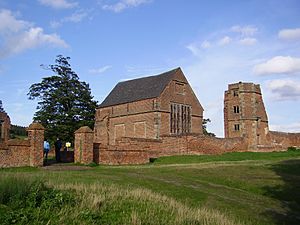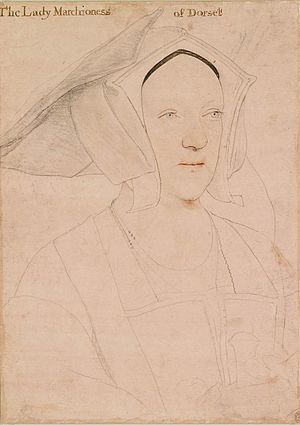Thomas Grey, 2nd Marquess of Dorset facts for kids
Quick facts for kids
The Most Honourable
The Marquess of Dorset
|
|
|---|---|

Arms of Thomas Grey,
2nd Marquess of Dorset, KG |
|
| Preceded by | Thomas Grey |
| Succeeded by | Henry Grey |
| Personal details | |
| Born | 22 June 1477 |
| Died | 10 October 1530 (aged 53) |
| Spouses | Eleanor St John Margaret Wotton |
| Children | Henry Grey, 1st Duke of Suffolk Edward Grey Lord Thomas Grey Lord John Grey Mary Grey Katherine Grey Elizabeth Grey, Lady Audley Anne Grey |
| Parents | Thomas Grey, 1st Marquess of Dorset Cecily Bonville, Baroness Harington and Bonville |
| Occupation | peer, courtier, soldier and landowner |
Thomas Grey, 2nd Marquess of Dorset (born June 22, 1477 – died October 10, 1530) was an important English nobleman. He was a peer, which means he was a high-ranking member of the nobility. He also worked as a courtier (someone who attends the royal court), a soldier, and owned a lot of land. Thomas Grey was part of the powerful House of Grey family.
Contents
Growing Up
Thomas Grey was the third son of Thomas Grey, 1st Marquess of Dorset. His father was the only marquess in England at that time. His mother was Cecily Bonville, Baroness Harington and Bonville. She was very rich and inherited a lot of land. Thomas's grandmother was Queen Elizabeth Woodville. This made his father the stepson of King Edward IV and half-brother to King Edward V.
Some people believe young Thomas went to Magdalen College School, Oxford. It's also thought that Cardinal Wolsey might have been one of his teachers. Later, during a trip to France, a famous scholar named Erasmus helped guide him.
Thomas's father was against King Richard III. After a failed rebellion in 1483, Thomas and his father ran away to Brittany. They joined Henry Tudor, who later became king. Henry Tudor became king after winning the Battle of Bosworth Field in 1485. Five months later, Henry VII married Thomas's father's half-sister, Elizabeth of York.
Even though they were related, King Henry VII was careful about Dorset. In 1487, during a rebellion, Dorset's father was put in prison. In 1492, Dorset's father had to promise loyalty to the king. As part of this, young Thomas Grey became a "ward of the king." This meant the king would look after him and his property.
Serving the King

Because they were close to the Queen, Thomas and his younger brothers, Leonard and Edward, were welcomed at court. They became courtiers and later soldiers. In 1494, Thomas was made a knight of the Bath. In 1501, he became a knight of the Garter.
Also in 1501, his father passed away. Thomas inherited his father's titles and some of his lands. However, much of his father's land went to his mother. Thomas didn't get his full inheritance until his mother died in 1529. This was just before his own death.
Later in 1501, Thomas played a key role at the wedding of Arthur, Prince of Wales, and Catherine of Aragon. He received a special diamond and ruby Tudor rose at a court tournament. But in 1508, he was sent to the Tower of London. He was later moved to a prison in Calais. This was because he was suspected of plotting against King Henry VII.
Luckily, King Henry VIII came to the throne in 1509, which saved Thomas from execution. At first, he lost his titles. But later in 1509, he was pardoned and returned to court. He was called to parliament as Baron Ferrers of Groby. In 1511, he was again called as Marquess of Dorset.
From 1509, Dorset was very active at court again. He did very well in many court tournaments. In one event in March 1524, he had a very close call with the king during a tournament.
In 1514, Dorset helped escort King Henry VII's daughter, Princess Mary, to France. She was going there to marry King Louis XII.
Dorset owned land in many parts of England. He was also a justice of the peace in several areas. This meant he helped keep law and order. In 1516, he had a rivalry with another nobleman in Leicestershire. Dorset brought too many followers to court. He was brought before the Star Chamber and the Court of King's Bench. He had to promise to behave well. During this time, he made his family home at Bradgate Park much larger.
In 1520, at the famous Field of Cloth of Gold meeting, Dorset carried the sword of state. In 1521, he met the Holy Roman Emperor Charles V in France. He then escorted him on a visit to England. Dorset also helped entertain the court by having his own group of actors.
In 1521, Dorset was part of the group that judged the Duke of Buckingham. This was even though they were related. King Henry VIII rewarded Dorset with some of Buckingham's lands.
From 1523 until his death, Dorset was a "Justice in Eyre" south of Trent. This meant he oversaw courts that dealt with laws about royal forests.
In 1524, Dorset's rivalry with Lord Hastings in Leicestershire became a large fight involving hundreds of men. Cardinal Wolsey stepped in to stop it. Both noblemen had to pay a large sum of money to promise good behavior. Dorset was sent to Wales to lead Princess Mary's Council.
In 1528, Dorset became the constable of Warwick Castle. In 1529, he became constable of Kenilworth Castle. A constable was in charge of keeping the castle safe.
In 1529, Dorset was an important witness in favor of King Henry VIII's divorce from Catherine of Aragon. He strongly supported the king's claim that Arthur and Catherine's marriage had been fully completed.
In 1530, near the end of his life, he helped the King in the legal process against Cardinal Wolsey.
A Soldier's Life
In 1512, Dorset led an English army to France. This was during the War of the League of Cambrai. The goal was to take back Aquitaine, a region England had lost long ago. But the mission was not successful. Ferdinand of Aragon had promised help but did not give it. Ferdinand kept delaying and tried to get Dorset to attack Navarre instead of Aquitaine.
Meanwhile, the English army ran out of food, beer, and money. Many soldiers got sick from drinking too much wine. The army then rebelled against their leaders. When Dorset returned to England, he had to face a trial.
In 1513, he fought in the siege of Tournai and the Battle of Guinegate. He also fought again in 1523 in the Scottish borders. These battles gave him chances to make up for the failed mission in Aquitaine. To help him deal with the Scots, he was made Lord Warden of the Marches. He also rejoined the Privy Council and became a gentleman of the chamber.
His Family and Children
Thomas Grey was the son of Thomas Grey, 1st Marquess of Dorset and Cecily Bonville. His mother, Cecily, was a very wealthy heiress. His paternal grandparents were Queen Elizabeth Woodville and Sir John Grey of Groby. This meant his father was King Edward IV's stepson and King Edward V's half-brother.
Marriages and Children
Thomas Grey was first supposed to marry Anne St Leger in 1483. But this marriage did not happen.
Instead, Thomas Grey first married Eleanor St John. She was the daughter of Oliver St John. Eleanor was also a first cousin to King Henry VII.

In 1509, Thomas Grey married his second wife, Margaret Wotton. She was the daughter of Sir Robert Wotton. Margaret had two famous brothers: Sir Edward Wotton and Nicholas Wotton. Nicholas was a diplomat who helped arrange King Henry VIII's marriage to Anne of Cleves.
With Margaret, Thomas Grey had four sons and four daughters. Their most famous son was Henry Grey, 1st Duke of Suffolk (born 1517). Their daughter Elizabeth married Thomas Audley, 1st Baron Audley of Walden. Thomas Grey's second wife, Margaret, lived longer than him.
Thomas's younger brother, Leonard Grey, 1st Viscount Grane, served as the Lord Lieutenant of Ireland from 1536 to 1540.
Dorset's son, Henry, became the next Marquess of Dorset. Henry married Lady Frances Brandon, who was a granddaughter of King Henry VII. In 1551, Henry became the Duke of Suffolk.
Dorset's granddaughter, Lady Jane Grey, was chosen by King Edward VI to be his successor. For nine days in July 1553, she was briefly the Queen of England. In 1554, Henry Grey and Dorset's other sons, Lord John Grey and Lord Thomas Grey, took part in a rebellion. This rebellion was against Queen Mary I's marriage to Philip of Spain. It also supported Lady Jane Grey.
When the rebellion failed, all three brothers were arrested. Henry Grey and his brother Thomas were executed. Lady Jane herself and her husband were also executed. Lord John Grey survived. Later, in 1603, his youngest son was given back the title of Baron Grey of Groby by King James I.
His Final Years
Thomas Grey, Marquess of Dorset, passed away on October 10, 1530. He was buried in the church at Astley in Warwickshire. When he died, he owned land in London and sixteen other counties. He had over one hundred manors, which made him one of the richest men in England. His grave was opened in the early 1600s. Measurements of his skeleton showed he was about 5 feet 8 inches (173 cm) tall.

